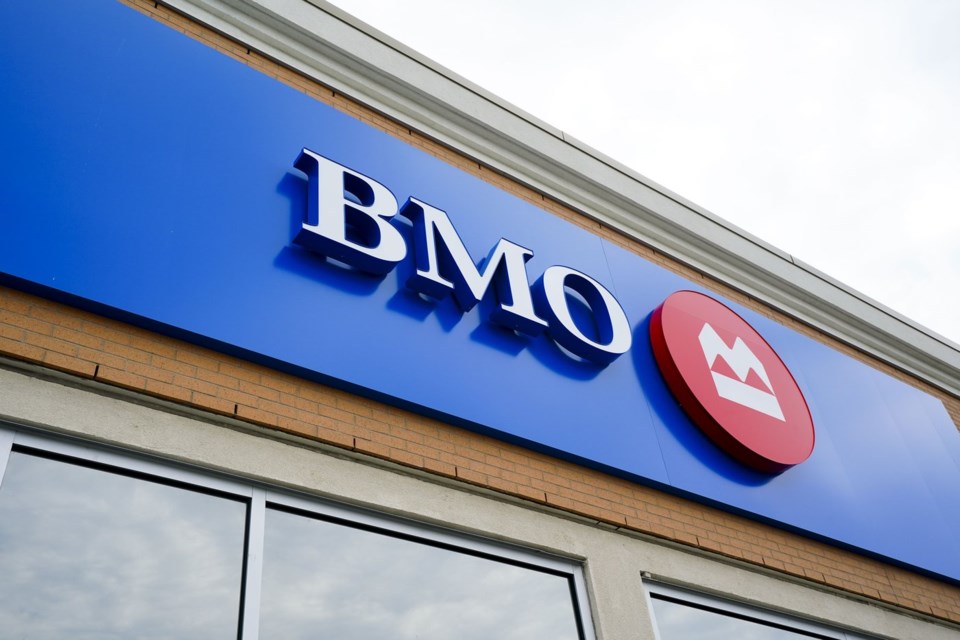TORONTO ŌĆö BMO Financial Group boosted its provisions for potential bad loans in the fourth quarter, but the bank said Thursday it expects loan performance to improve next year.
The bank reported a fourth-quarter profit of $2.3 billion, up from last year thanks to a $1.18 billion pre-tax boost from the reversal of a legal judgment related to a Ponzi scheme in the United States.
But its adjusted earnings, which excluded the one-time gain, showed a profit of $1.54 billion, down from $2.24 billion in the same quarter last year.
The drop came as its provisions for credit losses surged to $1.52 billion from $446 million a year earlier, and up from the already elevated $906 million in its third quarter.
The provision included $1.11 billion set aside for the more serious impaired category where it's even less confident it will have the loans paid back.
"Credit performance deteriorated more than we anticipated," chief executive Darryl White told a conference call with investors and financial analysts to discuss the company's financial results.
BMO chief risk officer Piyush Agrawal said high interest rates have been the main headwind on loan stress, while newer client relationships and changing consumer preferences have also contributed to the rise in provisions.
With unemployment in Canada still elevated, the retail banking division is expected to see further increases into next year.
The overall picture should start to improve next year though, Agrawal said.
"While we expect provisions to remain elevated, we believe that Q4 represents a high point, and will begin to moderate through 2025," he said.
The timing of any turnaround is unclear, but the bank expects to see its loan books more positive ahead, White said.
"I would define us as 'net bullish.' And why I say that is because there are clearly some crosswinds, we don't know where we're going to land on the pace of monetary and fiscal change, but I will say that ... the U.S. in particular, there isn't any question that since the election, we've seen pretty broad based optimism in our client base," he said.
The bank has improved its process on client selection and due diligence to help reduce risk for new loans, avoiding issues it had when taking on a wave of new clients in 2021 that have become a problem, White said.
"In hindsight, the client selection as a result of that wasn't exactly ideal."
On an adjusted basis, BMO said it earned $1.90 per diluted share in its latest quarter, down from an adjusted profit of $2.93 per diluted share a year ago.
The average analyst estimate had been for an adjusted profit of $2.41 per share, according to data provided by LSEG Data & Analytics.
Jefferies analyst John Aiken said the higher loan loss provisions in the quarter led to the miss as BMO looked to make sure it had thoroughly accounted for potential bad loans.
ŌĆ£Provisions came in significantly higher than expectations as BMO appears to be trying to clear the decks," he said in a note.
"Commercial impaired provisions were significantly higher from an already elevated third quarter. ... In addition, more than $400 (million) in provisions on performing loans should provide some measure of support against future deterioration."
Offsetting some of its loan issues was the reversal of the legal ruling related to the Ponzi scheme in the quarter.
That boosted the bank's capital levels and helped allow it to roll out a 20 million share buyback program on Thursday, on top of an increase in its quarterly dividend of four cents to $1.59 per share.
White said the moves show his confidence in the bank going forward.
"We're net confident in the U.S. and otherwise, and that's underpinned by the decisions we've made with respect to dividend increase and normal course issuer bid," he said.
BMO, which fell more than four per cent in early trading on the Toronto Stock Exchange, were up $4.12 or about three per cent at $138.27 in afternoon trading.
This report by The 91įŁ┤┤ Press was first published Dec. 5, 2024.
Companies in this story: (TSX:BMO)
Ian Bickis, The 91įŁ┤┤ Press



